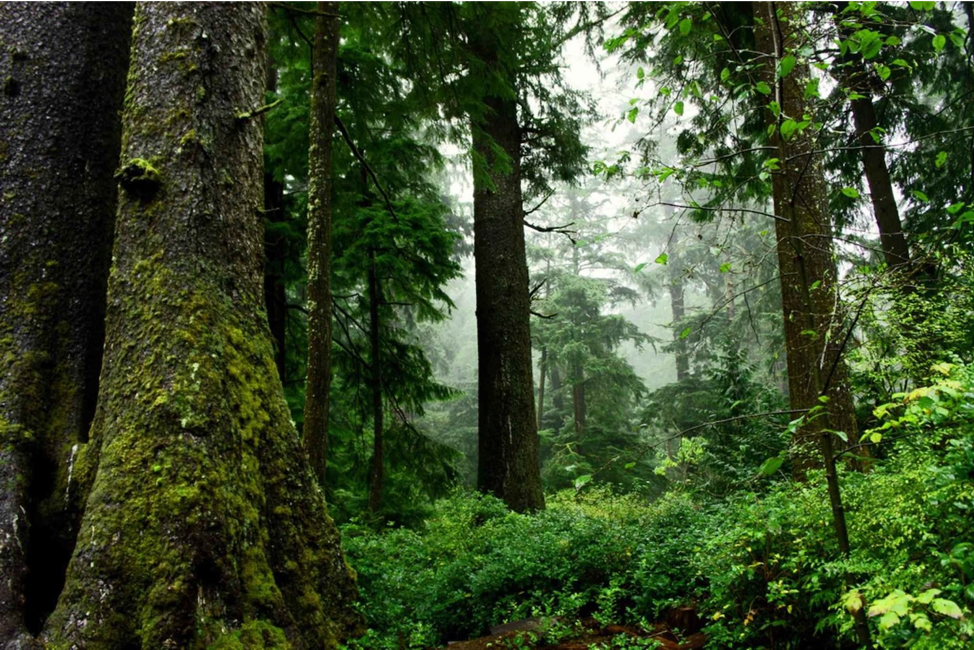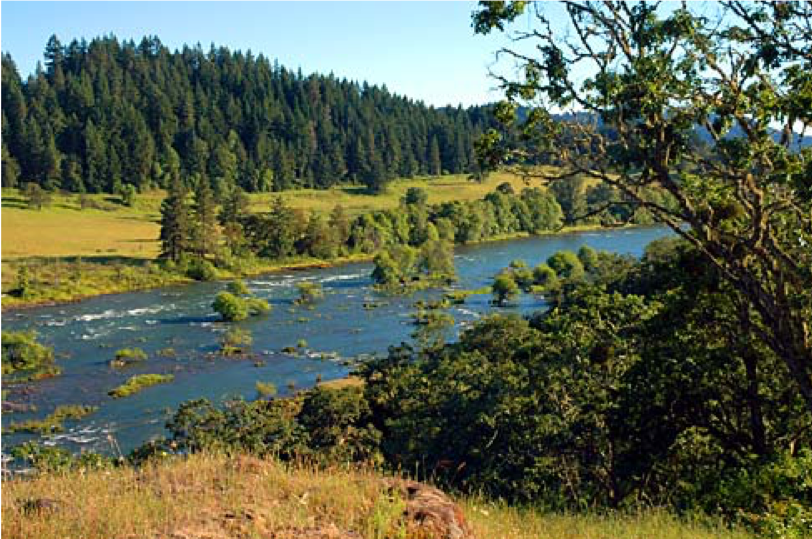Seeking Rights of Nature for Elliott State Forest
Figure 1 Old growth forest. Photo by Patte David, U.S. Fish and Wildlife Service
By Davis Hianik
Old-Growth Forests 101
Contrary to popular belief, experts struggle to define old growth forests. Robert Leverett summarizes the four main ways that scientists and forestry professionals have define old-growth forest in the opening chapter of Eastern Old-Growth Forests: Prospects for Rediscovery and Recovery.
Definitions that emphasize lack of disturbance by humans (at least post-colonization); there are abundant old trees some of which are approaching the maximum old-age for the species.
Definitions that use a minimum age (typically around 150 years) combined with presence of old-growth characteristics such as logs, snags (standing dead trees), canopy gaps etc.; some human disturbance may be permitted.
Definitions that emphasize stand development, in particular climax forest – that is, the forest is in a stable state where trees are dying of old age and being replaced, and may continue to be stable for centuries.
Definitions that use an economic threshold. Old-growth stands are past the economic optimum for harvesting – usually between 80-150 years, depending on the species.
According to the Food and Agricultural Organization, around 36 percent of forest in the world today is primary, or old-growth, forest. The United Nations estimates that 57 percent of the world’s forest is currently or has been subject to industrial logging.
Not everyone has old growth forests. researchers estimated that 98 percent of the world’s primary forests occur in just 25 countries. Half of this is found in just five developed countries: the U.S., Canada, Russia, Australia, and New Zealand.
With just 22 percent of the world’s standing primary forests are currently protected, or five percent of the world’s pre-agriculture forests – this leaves these forests vulnerable to destruction.
Benefits of old growth forests
Old growth forests benefit the ecosystem in ways that freshly planted (or monoculture) trees cannot in the form of:
Biodiversity. The complexity of the old-growth forest creates many habitats which support thousands of species, including soil arthropods, spiders, insects, mites, millipedes, lichen, fungi, mosses, small mammals, and bats.
Biological legacies. After a fire or windstorm, the dead trees become snags or fallen trees which in turn shelter many plants and animals, protect the soil, and enrich the soil as they decay. Biological legacies ensure that many species survive a fire or other disturbance, and the legacies help rebuild the ecosystem.
Resilience. Forests are dynamic and continue their ecological processes through all the changes, a quality known as resilience. A forest rich in biodiversity and biological legacies is resilient.
Specifically, old growth forests provide a range of critical services including:
Production and regulation of water
Formation and retention of soil
Regulation of atmosphere and climate
Regulation of disturbances plus nutrients and pollution
Providing habitat, food, pollination, pest control
Productsion of genetic, medicinal, aesthetic, recreational, spiritual, scientific and educational resources
Figure 2 A North Bank Road view of the Umpqua River. Gary Halvorson, Oregon State Archives
Elliott State Forest - Oregon Coastal Range
Enter the Elliott State Forest located on the magnificent Oregon Coastal Range, the first state forest established in Oregon (named after the first states forester Francis Elliott). Stretching 18 miles long (north to south) and approximately 16 miles wide (west to east), this area includes the beautiful Umpqua River bordering the northern section of the forest.
Over to the west, the Elliott State Forest borders almost six miles of the Pacific ocean. On the eastern side, rich old-growth forest extends about 21 miles inland. In total, the Elliott State Forest used to cover 93,282 acres, mostly located in Coos and Douglas Counties.
Trees commonly found in this forest are the Douglas-fir, western hemlock, western redcedar, bigleaf maple, and red alder. For years this site has been logged for the Oregon Common School Fund, generating millions of dollars of lumber sales – leaving just 41,000 acres of old-growth forest. Even so, it remains one of the largest uncut areas left in the Oregon Coast Range.
The Elliott State Forest provides critical habitat for endangered species including Marbled Murrelet, Northern Spotted Owl, elk, and many species of salmon. In fact, 22% of all wild Oregon Coast Coho salmon originate in the Elliott’s rivers and streams.
Carbon Cycle
Nature, one of the top scientific journals, has found that the rate of tree carbon accumulation increases continuously with tree size. This means that big, mature trees capture the most carbon dioxide (CO2). Yet selective logging usually removes the bigger trees, so this new research supports the Greenpeace campaign for zero (gross) deforestation, globally, by 2020.
In the Elliott State forest, old-growth trees provide an unmatched donation to the carbon cycle that can be tributed to the large amount of vegetation preserved. Forests store carbon that would otherwise contribute to climate change. As the trees continue to grow their carbon capture ability grows with age. Preserving the Elliott State Forest allows for the continued growth of old-growth trees which is beneficial for capturing and storing carbon that would otherwise be released into the atmosphere.
Old-growth forests have notoriously been used by logging companies for large economic incentive due to their massive lumber yield. In the pacific northwest, old-growth is defined as trees older than 250 years with the presence of some trees recorded over 1000 years old. Because of their rich biodiversity, old-growth forests are often home to endangered, threatened, and rare species.
Threats to the Elliott State Forest
Old-growth forests once covered much of Oregon, but today less than 10 percent of the state’s heritage forests remain. Much of what survives is found on US Forest Service and Bureau of Land Management lands that are still actively targeted for logging.
In 2017, two of the three members of Oregon's State Land Board voted to sell the Elliott State Forest to a private timber company for clearcutting. Oregon Wild and coalition partners helped mobilize a powerful grassroots response to persuade Tobias Read to reverse his position and express support for keeping the forest public. On May 9, Read, Governor Kate Brown and Republican Dennis Richardson voted unanimously to halt the sale and keep the Elliott public.
For now, this is a most decisive win for this old growth forest. Looking ahead, however, there is still no protection against future development or sales of the Elliott-State Forest.
Actions to protect Elliot State Forest
The Oregon Legislature allocated $100 million in bonding revenue to help keep the forest public for the diversity of services it provides including clean water, old-growth forests, salmon and wildlife habitat, carbon storage and recreation opportunities. Currently owned by the public, this land is still vulnerable to the lease of private entities in the near future.
The Elliott State Forest harbors a unique and rare island of biodiversity. Surrounded on three sides by industrially managed tree plantations and clearcuts, species also can’t easily migrate out of the area. In 1990, the Endangered Species Act included the Northwest Spotted Owl, the Marbled Murrelet in 1992, and Coho Salmon in 1998 which led to a reduction in logging. Managing the Elliott is costing the state more than what’s earned from timber harvests, in part because of protected species restriction.
In December 2018, the State Land Board directed the Oregon Department of State Lands (DSL) to work collaboratively with Oregon State University (OSU) to develop a plan for transforming the Elliott State Forest into a research forest. A successful plan will be consistent with the Land Board vision for the forest, which includes:
Keeping the forest publicly owned with public access
Decoupling the forest from the Common School Fund, compensating the school fund for the forest and releasing the forest from its obligation to generate revenue for schools
Continuing habitat conservation planning to protect species and allow for harvest
Providing for multiple forest benefits, including recreation, education, and working forest research
DSL and OSU anticipate a proposed plan will be presented to the Land Board for consideration in December 2019.
Earth Law strengthens protection of Elliott State Forest
The old growth forest ecosystem of the Elliot State Forest could be considered an entity with inherent rights. Legally recognizing those rights could help strengthen the protection of the Elliott State Forest from future predations. Precedents exist already for forests having rights. The wild Urewere Forest in the Hawkes Bay Region of New Zealand’s North Island gained rights recognition in 2014.
Earth Law Center works with local partners to seek Rights of Forests in El Salvador and other locations.
Earth Law aims to help communities and organizations protect the Nature around them by recognizing legal rights for those ecosystems and species. Rights of Nature is the recognition that our ecosystems – including trees, oceans, animals, mountains – have rights just as human beings have rights. Rights of Nature is about balancing what is good for human beings against what is good for other species, what is good for the planet as a world. It is the holistic recognition that all life, all ecosystems on our planet are deeply intertwined.
Isn’t it time that we recognized the right of the Elliott State Forest to exist, thrive and evolve?


